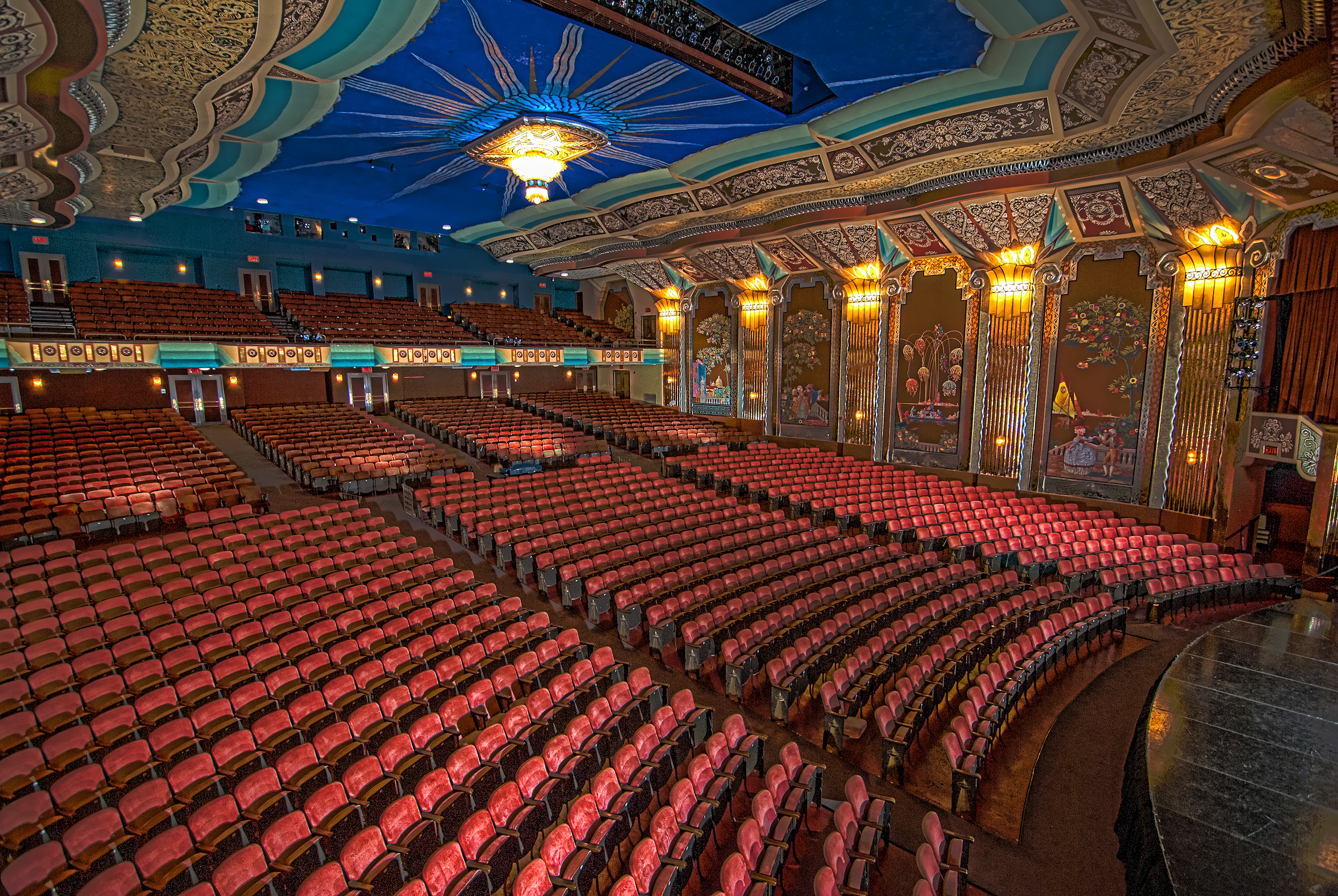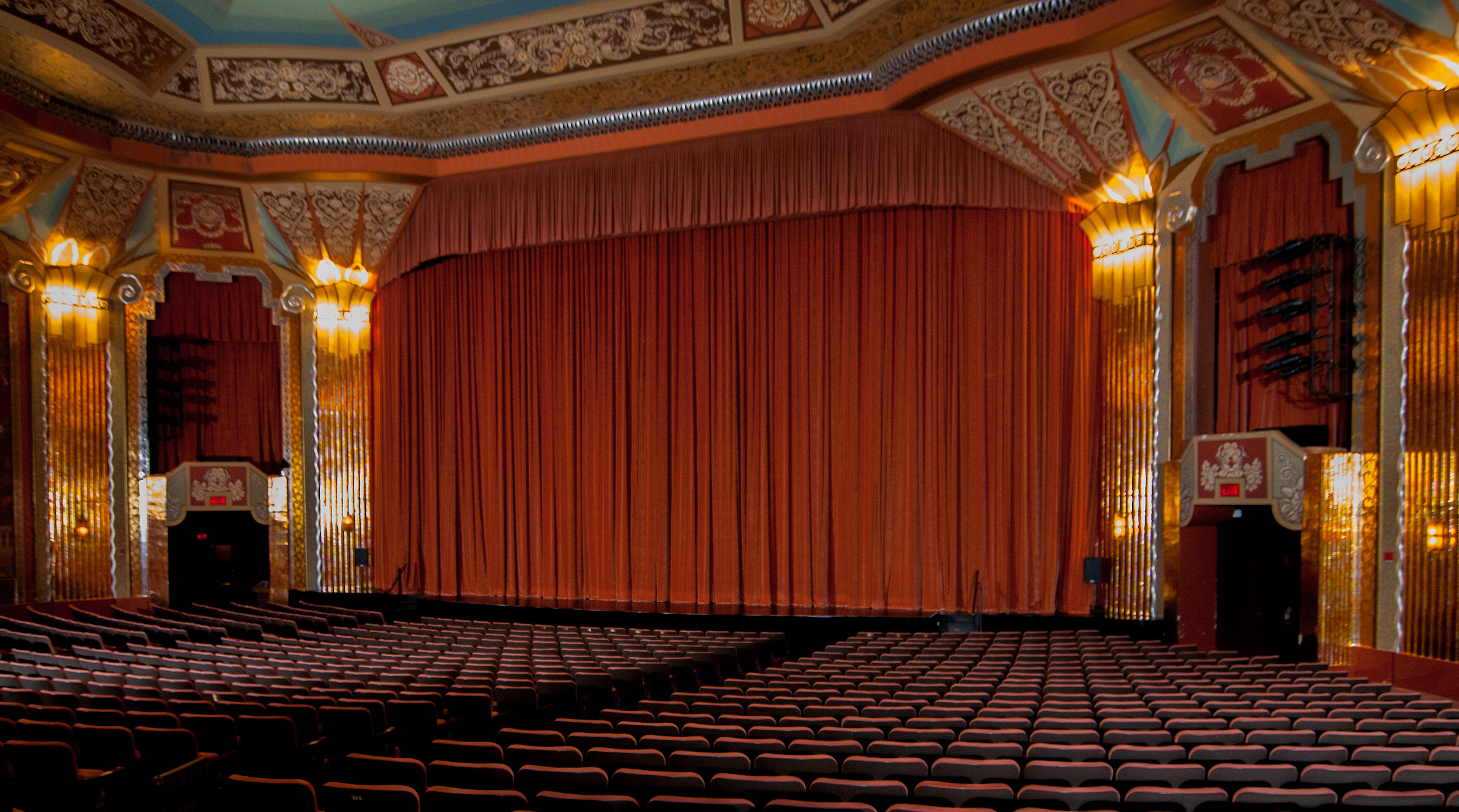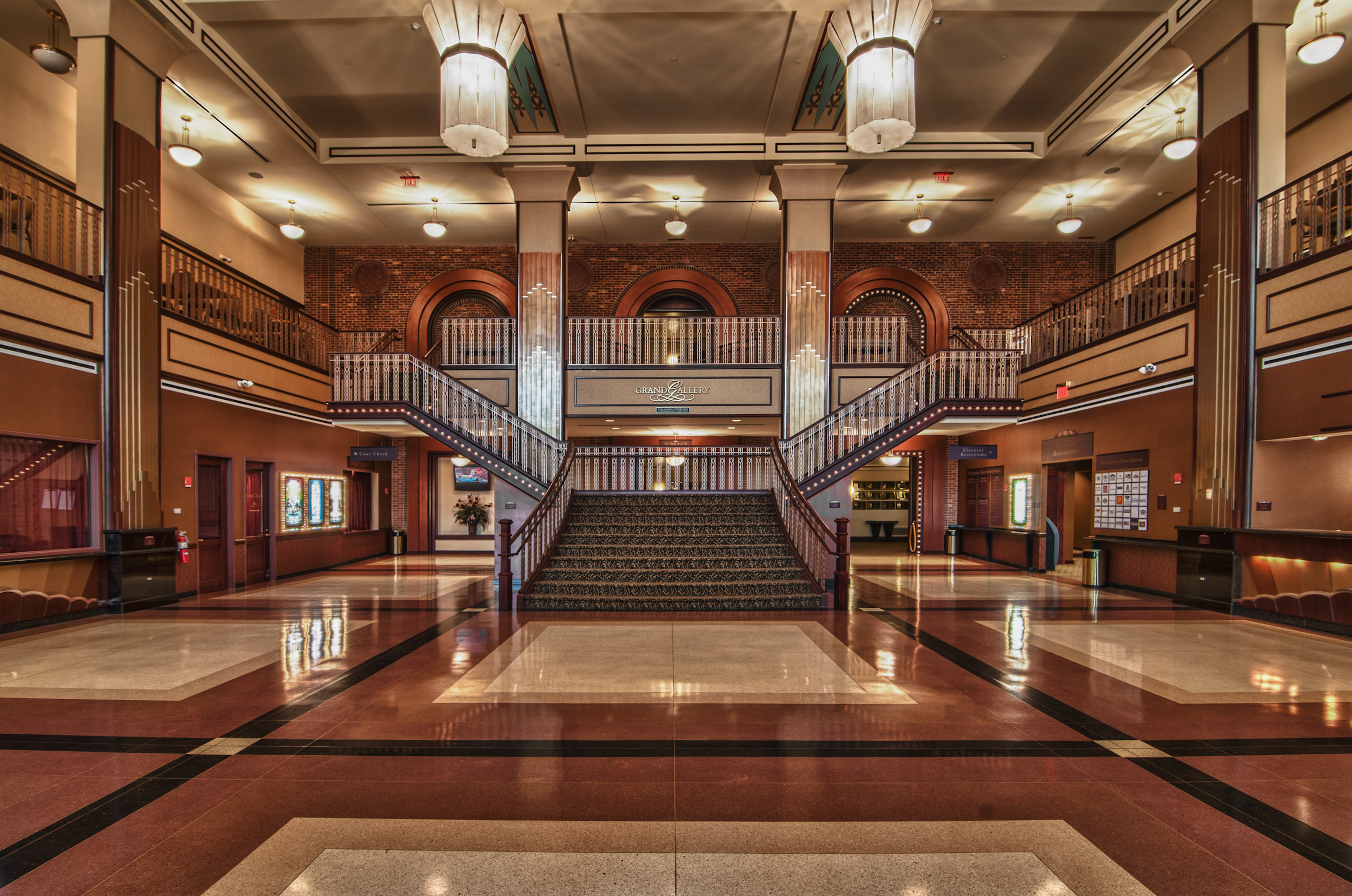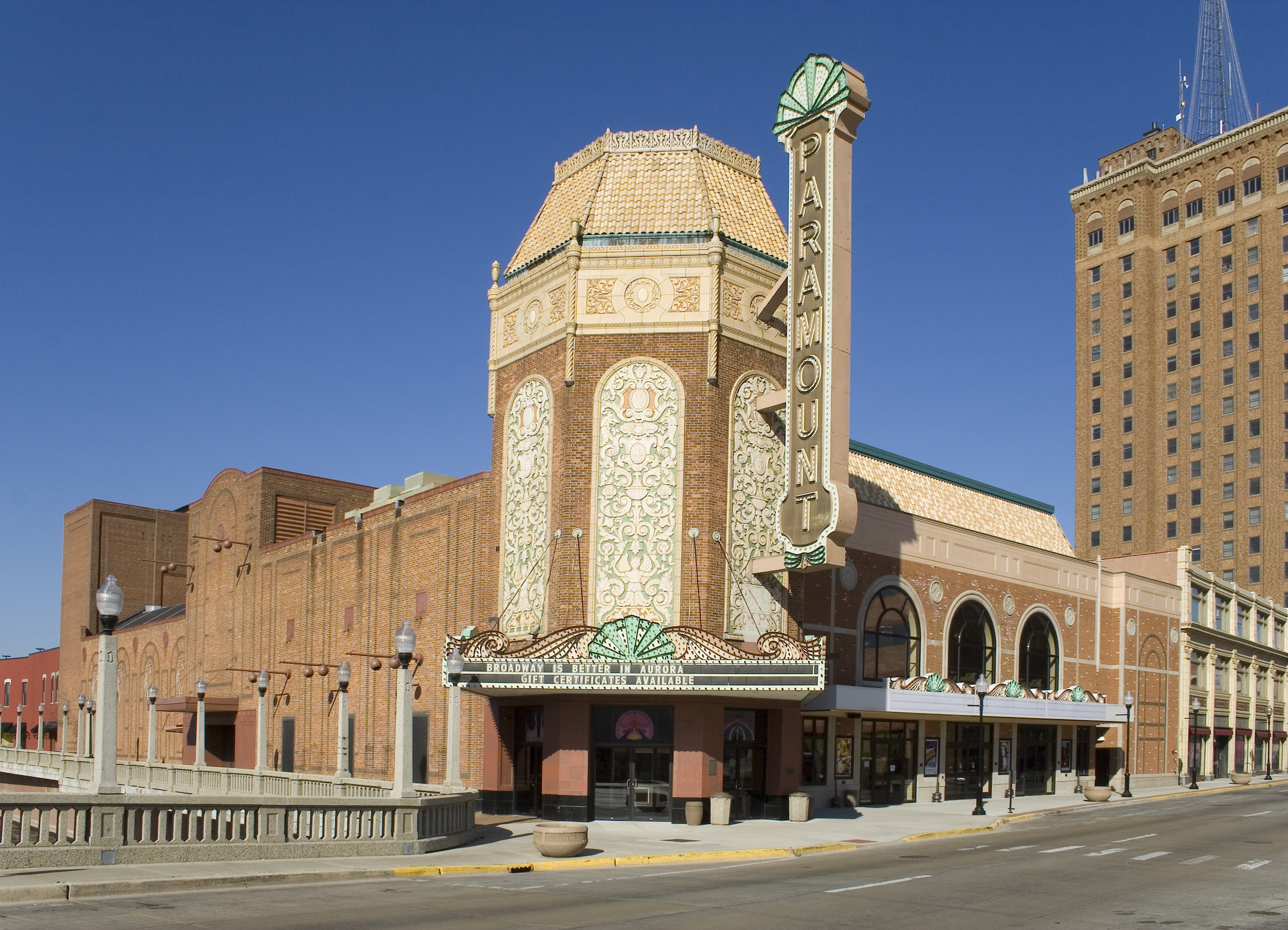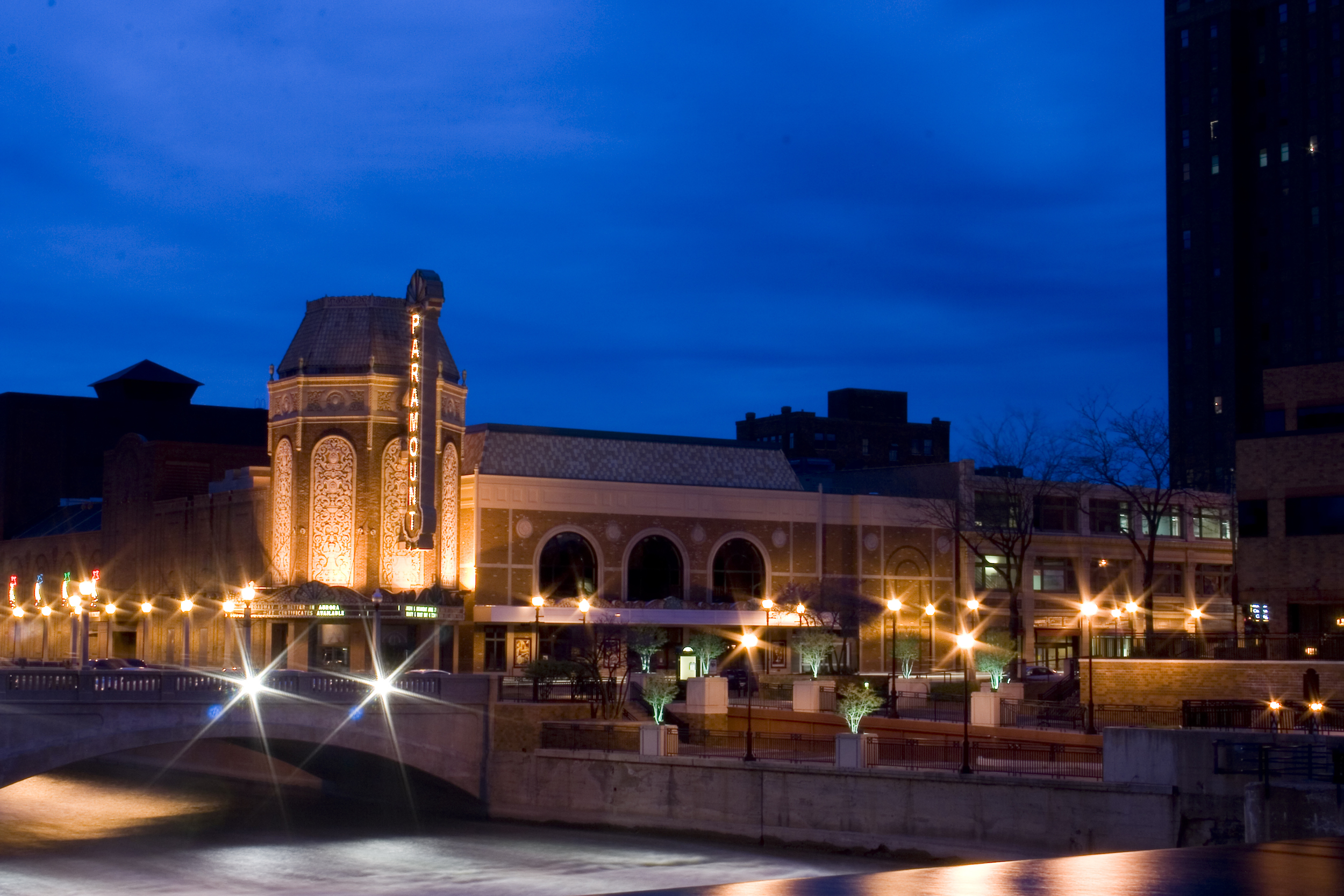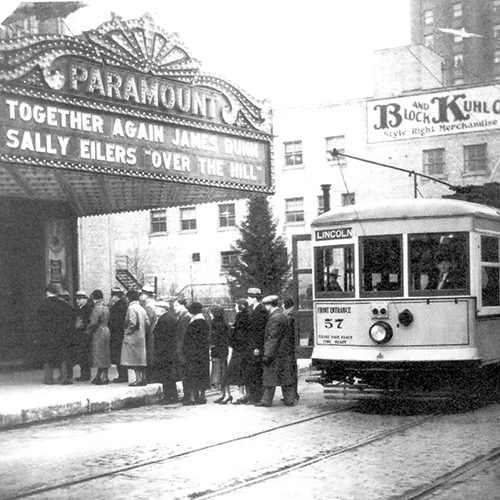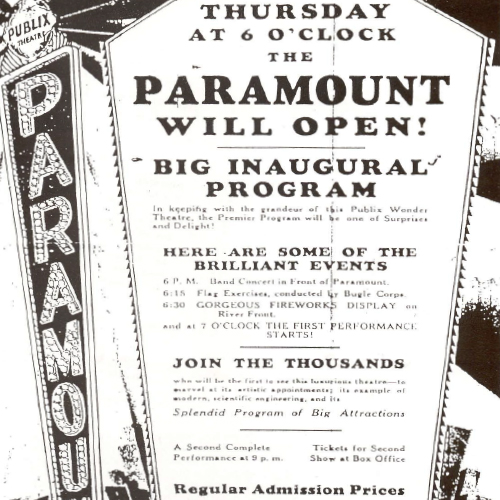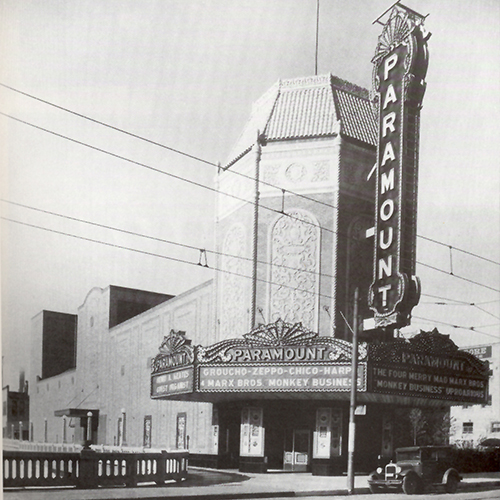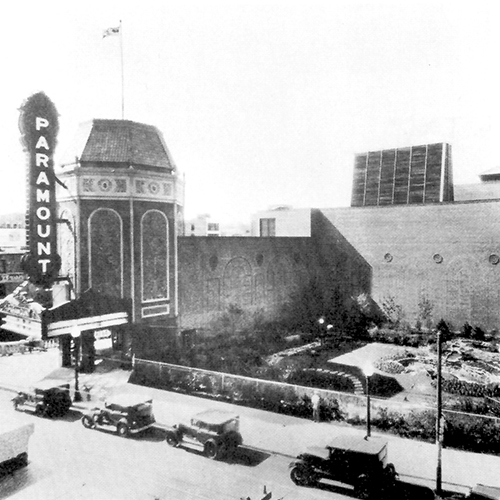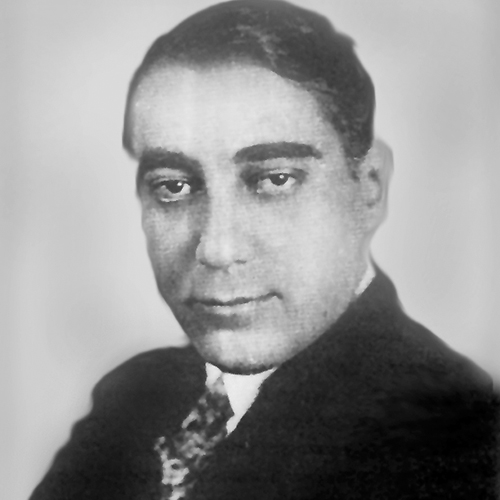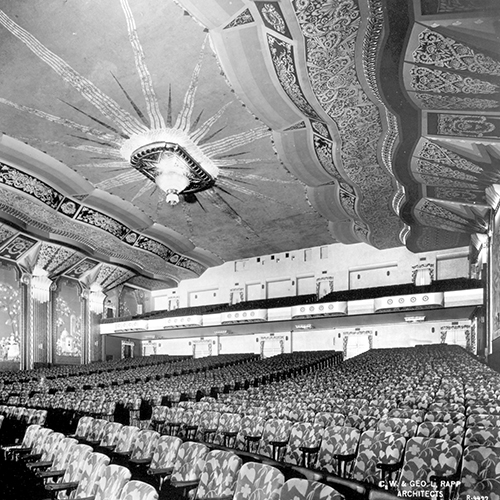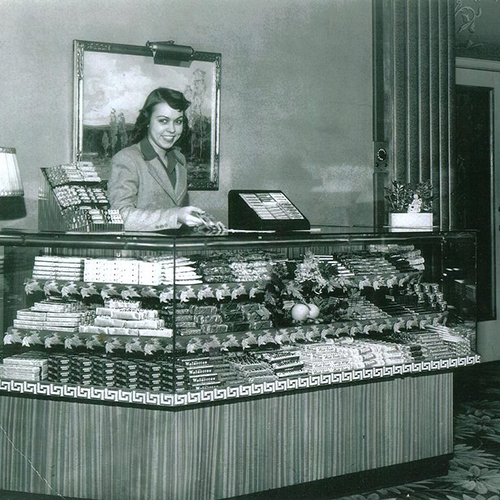Mission, Timeline & History
History
Our Mission
The Aurora Civic Center Authority is committed to being a defining catalyst for personal and community transformation by:
making the performing arts accessible for every age and socioeconomic background,
introducing the magic of live theater across generations to encourage expansive imaginations and broad views of people and the world,
and contributing to the future stability and growth of Aurora’s downtown.
Paramount’s Timeline
Paramount’s History in 4 Acts
Act 1 – 1915-1931
Building the Palace
The historic landmark at the center of downtown Aurora that you know and love today for bringing Broadway caliber theater to Chicagoland has a long and rich background that has provided endless, diverse entertainment over the past 100 years.
Long before the construction of the current Paramount Theatre, Aurora had already established itself as a center for entertainment. At the turn of the 20th Century, vaudeville and silent films could be seen in many local venues, including Dreamland, The Majestic, The Strand (formerly the Grand Opera House) and The B.
In 1915, J.J. Rubens and other far-seeing theatre owners formed the Aurora Theater Company. New theatres were needed to accommodate the movies’ transition to “talkies.” Rubens, on a trip to Italy, began envisioning plans for a new theatre with a Venice theme—The Venetian. He called upon C.W. and George L. Rapp, nationally known architects of movie theatres, to be the designers. Combining Rubens’ Venetian theme with the fashionable Art Deco influence of the 1920s and early 1930s, Rapp & Rapp designed a breathtaking palace…what David Naylor referred to in American Picture Palaces – The Architecture of Fantasy as “their best Art Deco theatre.”
In 1930, prior to construction, Aurora Theater Company was sold to the Paramount-Famous-Lasky Corporation and renamed The Paramount, rather than The Venetian. The $1 million dollar building opened on September 3, 1931, to wonder, excitement, glamour, laughter and music. An organist was flown in to play the Wurlitzer organ, local dignitaries attended the opening, and telegrams arrived from Paramount Studios stars such as Claudette Colbert, Sylvia Sydney, and Janet Gaynor.
Act 2 – 1931-1987
The Roadhouse & Restoration
In addition to movies, Paramount also offered vaudeville, concerts, sing-a-longs and circus performances, all inside Illinois’ first air-conditioned building outside of Chicago. Acoustics and sightlines had been so well designed that there was not one bad seat in the house. Equally important, the luxurious theatre gave its patrons a brief respite from the troubles of the Great Depression.
Over the decades that followed, Paramount became a choice spot for touring shows to visit for a night or two, drawing large crowds. In the early days, Paramount film stars such as The Marx Brothers, Jack Benny and Burns and Allen performed by the Fox River on the iconic stage.
After 40 years of serving Aurora and the surrounding communities, age began to take its toll. Dirt and grime covered the walls, and beautiful murals, upholstery and curtains had become tattered and torn. In 1965, the Aurora Civic Center Authority and the Aurora Redevelopment Commission (ACCA/ARC) were established, heralding the beginning of downtown redevelopment in Aurora. ACCA/ARC applied for and received funds of $15 million – $4.5 million from general revenue bonds issued by the city, and $10.5 million from state racetrack revenue.
Paramount was open continuously until 1976 when ACCA purchased it from the Plitt Corporation. Plans to restore the interior decor to its former grandeur were soon underway. Working from black-and-white photographs dating back to 1931, obtained from the Theatrical History Society, Schmitt artisans and craftsmen gutted the interior and began restoration.
Since the reopening of Paramount Theatre on April 29 in 1978, the goal has been not just to maintain a presence as a center for the arts in Aurora, Illinois, but to contribute to the future stability and growth of Aurora’s downtown. Shows were continually produced during this time, even as the landscape changed around the town. In 1980, Paramount Theatre was placed on the National Register of Historic Places, and in1983 North Island Center opened. A park was built in 1987 that later was demolished to make way for an expansion of the building by adding the Grand Gallery, currently a favorite spot for VIP events and wedding ceremonies when the theatre is not in use.
Act 3 – 2010-2024
Broadway & Beyond: Creating the Arts District
It wasn’t until 2010, when the current CEO and President Tim Rater was hired, that Paramount’s programming growth really began to take off, followed by the hiring of Jim Corti in 2011 as Artistic Director of the company.
Rater and Corti put together the first season of the popular Broadway Series in 2011, bringing classic musicals to the iconic Paramount stage—My Fair Lady and Joseph and the Amazing Technicolor Dreamcoat, A Chorus Line and Hair. As a result of that successful first season, the programing began to expand and diversify as ACCA venues increased to meet demand. The outdoor concert venue RiverEdge Park was constructed along the Fox River in 2013 and has since hosted many music greats, including Loretta Lynn, KISS, Steve Miller, Peter Frampton, Willie Nelson, John Fogerty, Three Dog Night and Poi Dog Pondering.
Meyer Ballroom opened its doors to host weddings and special events inside the North Island Center building in 2015, offering an opulent setting for couples to consider for their big day. That same year, Paramount Theatre became eligible for the prestigious Chicagoland theater awards known as Jeff Awards, and brought home five wins, establishing itself as a regional, equity theatre of note.
Banking on the growing success of the theatre itself, Rater fulfilled a dream that had been many years in the making. On June 1, 2019, Paramount School of the Arts opened its doors, offering classes for all ages in theater, music, dance and visual arts. The enrollment for the arts school has doubled in recent years, indicating the need for arts education in the region.
This expansion was soon followed in 2021 by the opening of an intimate and renovated 165-seat Copley Theatre in the North Island Center. This new space launched the BOLD Series, designed to balance the dazzling musical productions of the Broadway Series with adventurous, daring shows that address compelling themes.
In July of 2024, the creation of a third theater expanded the offerings for the region when Stolp Island Theatre opened along the riverfront with 98 seats. This flexible black box venue was created with the intention of reinventing it as a fully immersive environment for every show produced there. Aurora’s first long running show, Million Dollar Quartet, soon immersed audiences in a historic scene from 1956 at Sun Studio in Memphis with the music of four greats from rock and roll history, Elvis Presley, Johnny Cash, Carl Perkins and Jerry Lee Lewis.
To further support innovation and local talent, Paramount has created several initiatives over the years, including a program called Spark Lab that aims to support emerging playwrights, and increase equity in the arts by fostering fantastic new theatrical works. Aligning with Paramount’s mission to introduce the magic of live theater across generations, another initiative introduced was Theatre for Young Audiences, where professionals from the performing arts industry work directly with artists to help nurture their talents and bring their stories to life for stages across the nation.
Paramount continues to provide world-class entertainment—including dance, music, Broadway-caliber theatre, and children’s programming—for an annual audience of patrons from over 250 communities. Over 35,000 of those patrons are proud to be Paramount Broadway Series subscribers.
Paramount’s mission is intended impact the community in multiple ways, including reaching across socio-economic barriers to hosts free community events such as pre- and post-show talks, workshops, and offer low-cost entertainment options such as $1 Classic Movie Mondays and Pay What You Can ticket nights for shows.
In 2024, Paramount increased its accessibility programming to include ASL shows, open captioned and audio described performances, and implemented interactive activities such as a touch tour and a sensory friendly performance.
Around this time, Paramount’s growth was mirrored in downtown Aurora’s revitalization. Learn more here.
Act 4 – 2025 & Beyond
Looking Ahead for Paramount
Both Paramount and downtown Aurora have made steady strides together in recent decades. With combined efforts, they have inspired cultural connections and economic growth, illustrating what can happen when a city values and centers live entertainment as a means to strengthen the community’s reach and impact on the region.
The proposed City of Lights Centre will further the Paramount mission, with seating for approximately 4,000, and serve as a hub of activity, widening the entertainment reach of Aurora even further into the Chicagoland and Midwest populations. Primarily serving as a concert venue with a world-class stage, the theatre will feature touring musicians, stand-up comedians, holiday extravaganzas and diverse programming that will resonate with the local and extended communities.
By creating a building of architectural significance that blends the best elements of modern venues with some of the tried-and-true elements of historic venues, Paramount will create an enjoyable, safe, and creative place for diverse audiences to gather and experience live music together.
Whatever is next for Paramount will clearly be impactful for the arts district in downtown Aurora and nearby suburbs. Meanwhile, the leadership of Paramount continues to dream big, producing award-winning shows, creating jobs, and increasing city revenue, all with the right mix of luck and determination, with the aim to make Paramount the region’s home for arts entertainment.
Mission
The Aurora Civic Center Authority is committed to being a defining catalyst for personal and community transformation by:
- making the performing arts accessible for every age and socioeconomic background,
- introducing the magic of live theater across generations to encourage expansive imaginations and broad views of people and the world,
- and contributing to the future stability and growth of Aurora’s downtown.
Old History Tab
Paramount’s Timeline
Building The Palace
Aurora has a rich history as a center for entertainment. At the turn of the 20th Century, vaudeville and silent films could be seen in many local venues, including Dreamland, The Majestic, The Strand (formerly the Grand Opera House) and The B.
In 1915, J.J. Rubens and other far-seeing theatre owners formed the Aurora Theater Company—a power group that guided Aurora’s moving picture business. New theatres were needed to accommodate the movies’ transition to “talkies.” Rubens, on a trip to Italy, began envisioning plans for a new theatre with a Venice theme—The Venetian. He called upon C.W. and George L. Rapp, nationally known architects of movie theatres, to be the designers. Combining Rubens’ Venetian theme with the fashionable Art Deco influence of the 1920s and early 1930s, Rapp & Rapp designed a breathtaking palace…what David Naylor referred to in American Picture Palaces – The Architecture of Fantasy as “their best Art Deco theatre.”
In 1930 however, prior to construction, Aurora Theater Company was sold to the Paramount-Famous-Lasky Corporation. Although it retained the Rapp & Rapp design, the theatre was renamed The Paramount, rather than The Venetian. The $1 million dollar building opened on September 3, 1931, to wonder, excitement, glamour, laughter and music. An organist was flown in to play the Wurlitzer, local dignitaries attended the opening, and telegrams arrived from Paramount Studios stars such as Claudette Colbert, Sylvia Sydney, and Janet Gaynor.
In addition to the movies, The Paramount also offered vaudeville, concerts, sing-a-longs and circus performances…all inside Illinois’ first air-conditioned building outside of Chicago. Acoustics and sight lines had been so well designed that there was not one bad seat in the house. The luxurious theatre gave its patrons a brief respite from the troubles of the Great Depression.
The Decline
After 40 years of serving Aurora and the surrounding communities, age began to take its toll. Dirt and grime covered the walls, and beautiful murals, upholstery and curtains had become tattered and torn. In 1965, the Aurora Civic Center Authority and the Aurora Redevelopment Commission (ACCA/ARC) were established, heralding the beginning of downtown redevelopment in Aurora, and in 1973 the state of Illinois established the Civic Center Support Program as a means of funding designated cities towards the revitalization of their downtown areas. ACCA/ARC applied for and received funds of $15 million – $4.5 million from general revenue bonds issued by the city, and $10.5 million from state race track revenue.
The Paramount was open continuously until 1976 when ACCA purchased it from the Plitt Corporation. Plans for restoration began immediately and the firm of D’Escoto and Associates was hired as construction manager. Conrad Schmitt Studios were commissioned to restore the interior decor to its former grandeur. Working from black-and-white photographs dating back to 1931, obtained from the Theatrical History Society, Schmitt artisans and craftsmen gutted the interior and began restoration.
The Restoration
The eight hand-painted murals were in such poor shape that they had to be replaced. Each mural was traced and repainted on flame retardant, silk-like fabric and returned to its original position. The warm burgundy, coral, and peach colors of the panels were used as the primary color scheme for the renovations, including the reupholstered original seats. Old veneer and wallpaper were removed and replaced; broken plaster areas were repaired and repainted. The fluted columns that separate the murals were made from plaster, as were most of the surfaces under the decorative work, and were originally clad in German gold leaf. This covering, too expensive to duplicate, was replaced with foil that approximated the original look.
The artwork decorating the ceiling was restored using old photographs as references, and by creating stencils traced from art that was undamaged. A mere 20 percent of the ceiling needed repainting, the other 80 percent needed only cleaning and retouching. Fortunately, most of the Paramount’s interior just needed touching up rather than replacing.
Paramount Today
Paramount continues to provide world-class entertainment—including dance, music, Broadway-caliber theatre, and children’s programming—for an annual audience of 350,000 patrons from over 250 communities. Over 40,000 of those patrons are proud to be Paramount Broadway Series subscribers. In addition, we’ve expanded operations with the recently-opened Paramount School of the Arts and are currently in the process of renovating Copley Theatre for our upcoming Bold Series, a provocative new theater adventure. At our sister venue, RiverEdge Park, we welcome well over 100,000 patrons each summer to enjoy some of the best artists in live music, including KISS, Steve Miller Band and much more. Paramount also hosts free community events, $1 Classic Movie Mondays and its opulent interiors provide a spectacular backdrop for private functions such as wedding receptions or corporate galas.
PARAMOUNT TOURS
Tours of the historic Paramount Theatre are available. Reservations are required and can be made by calling (630) 896-6666. $5 per person.

